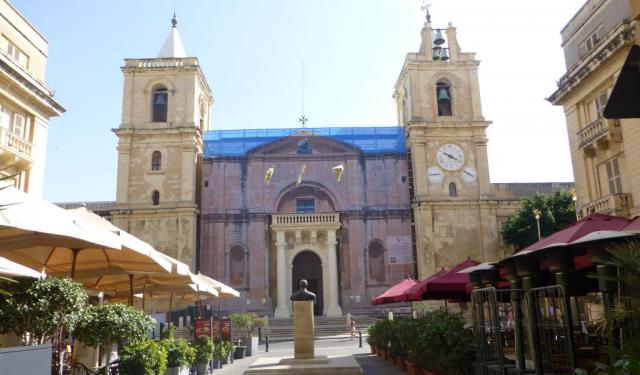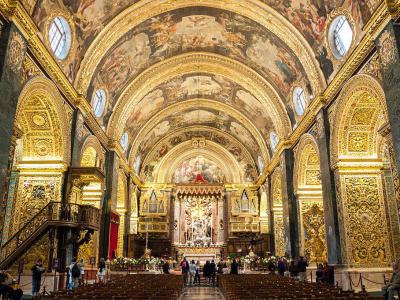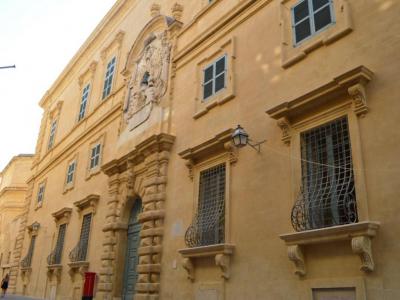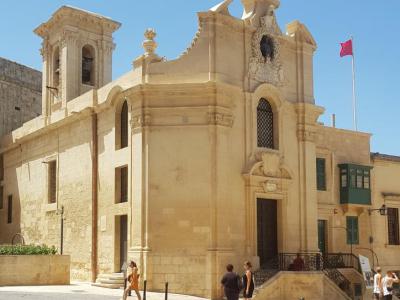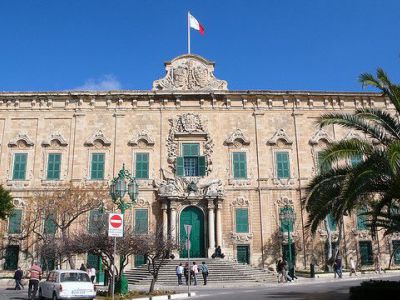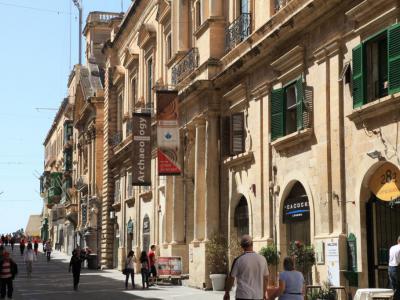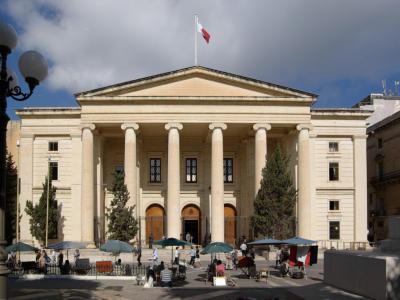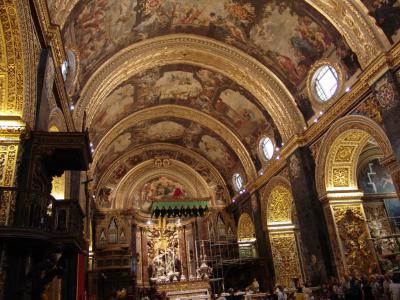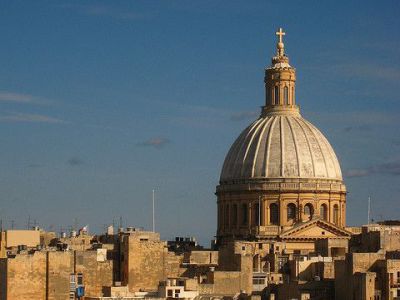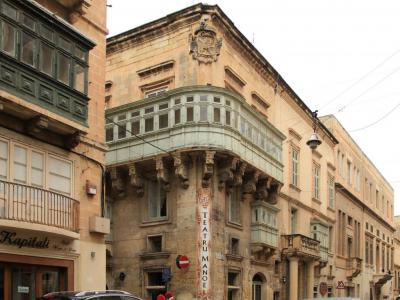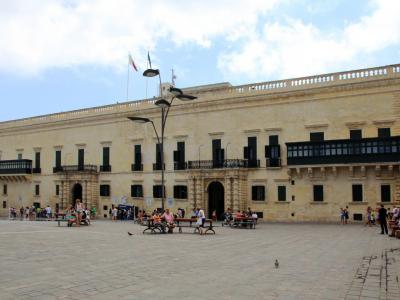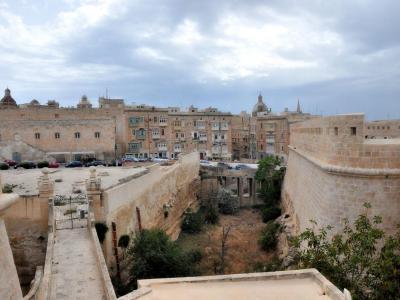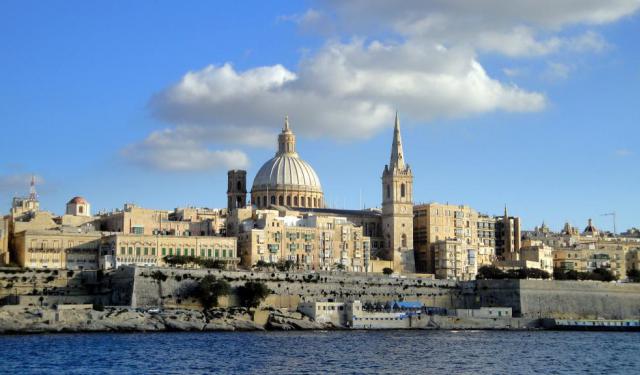Valletta Architectural Landmarks Tour (Self Guided), Valletta
Following the Great Siege of Malta in 1565, the knights of the Order of St John set about creating a city ‘built by gentlemen, for gentlemen’. The end result saw the island's capital become home to an array of elaborate Baroque buildings, some reflecting Mannerist features borrowed from neighboring Italy.
Many of these architectural monuments have proudly withstood the test of time since the 16th century, adding great elegance to the streets of Valletta, fit to impress even the most well-traveled visitor. Here is a rundown of some of the most awe-inspiring architectural landmarks not to be missed during your time in Valletta:
St. John's Co-Cathedral – a fort-like temple built by the Maltese knights in 1573-1578 shortly after the Great Siege.
Our Lady of Victories Church – designed to commemorate victory over the Ottomans during the Siege of Malta.
Auberge d'Italie – a former hotel built in the late 16th century to house knights of the Order of Saint John from the langue of Italy; now home to the National Community Art Museum.
Auberge de Castille – another ex-hotel; currently Office of the Prime Minister of Malta.
Manoel Theatre – reputed to be Europe's third-oldest working theater and the oldest working theater in the British Commonwealth.
Grandmaster's Palace and Armoury – officially known as The Palace, built between the 16th and 18th centuries as residence for the Grand Master of the Order of St. John, the then ruler of Malta.
Fort Saint Elmo - National War Museum – the star-shaped Fort, one of the most prominent and iconic features of Malta.
To acquaint yourself more closely with an assemblage of marvelous architecture found in the Maltese capital, check out this self-guided walking tour.
Many of these architectural monuments have proudly withstood the test of time since the 16th century, adding great elegance to the streets of Valletta, fit to impress even the most well-traveled visitor. Here is a rundown of some of the most awe-inspiring architectural landmarks not to be missed during your time in Valletta:
St. John's Co-Cathedral – a fort-like temple built by the Maltese knights in 1573-1578 shortly after the Great Siege.
Our Lady of Victories Church – designed to commemorate victory over the Ottomans during the Siege of Malta.
Auberge d'Italie – a former hotel built in the late 16th century to house knights of the Order of Saint John from the langue of Italy; now home to the National Community Art Museum.
Auberge de Castille – another ex-hotel; currently Office of the Prime Minister of Malta.
Manoel Theatre – reputed to be Europe's third-oldest working theater and the oldest working theater in the British Commonwealth.
Grandmaster's Palace and Armoury – officially known as The Palace, built between the 16th and 18th centuries as residence for the Grand Master of the Order of St. John, the then ruler of Malta.
Fort Saint Elmo - National War Museum – the star-shaped Fort, one of the most prominent and iconic features of Malta.
To acquaint yourself more closely with an assemblage of marvelous architecture found in the Maltese capital, check out this self-guided walking tour.
How it works: Download the app "GPSmyCity: Walks in 1K+ Cities" from Apple App Store or Google Play Store to your mobile phone or tablet. The app turns your mobile device into a personal tour guide and its built-in GPS navigation functions guide you from one tour stop to next. The app works offline, so no data plan is needed when traveling abroad.
Valletta Architectural Landmarks Tour Map
Guide Name: Valletta Architectural Landmarks Tour
Guide Location: Malta » Valletta (See other walking tours in Valletta)
Guide Type: Self-guided Walking Tour (Sightseeing)
# of Attractions: 12
Tour Duration: 2 Hour(s)
Travel Distance: 2.0 Km or 1.2 Miles
Author: gene
Sight(s) Featured in This Guide:
Guide Location: Malta » Valletta (See other walking tours in Valletta)
Guide Type: Self-guided Walking Tour (Sightseeing)
# of Attractions: 12
Tour Duration: 2 Hour(s)
Travel Distance: 2.0 Km or 1.2 Miles
Author: gene
Sight(s) Featured in This Guide:
- St. John's Co-Cathedral
- Auberge d'Italie - National Community Art Museum
- Our Lady of Victories Church
- Auberge de Castille
- Auberge de Provence - National Museum of Archaeology
- Courts of Justice building
- St. Augustine Church
- Basilica of Our Lady of Mount Carmel
- Manoel Theatre
- Grandmaster's Palace and Armoury
- Mediterranean Conference Centre (The Knights Hospitallers)
- Fort Saint Elmo - National War Museum
1) St. John's Co-Cathedral (must see)
Saint John's Co-Cathedral in Valletta represents the rich heritage of the Knights of Malta. Commissioned in 1572 by Grand Master Jean de la Cassière and completed just a few years later, it served as the conventual church of the Order of Saint John. The design was entrusted to Glormu Cassar, the Maltese architect responsible for many of Valletta’s early buildings.
From the outside, the cathedral has a plain, fortress-like appearance—a reminder that it was built shortly after the Great Siege of 1565, during a time when defense shaped every corner of the new capital. The simplicity of the façade prepares visitors for the dramatic contrast they will encounter inside.
Once inside, you enter a very different world. Richly decorated walls are carved directly into the stone, and painted scenes from the life of Saint John by 17th-century Italian Baroque artist Mattia Preti cover the interior. Don’t miss the ceiling: Preti’s use of light and shadow makes some figures appear almost to lift off the surface. One of the most remarkable features is that the elaborate carvings were created directly on the walls, rather than being added later.
Make your way to the Oratory, located just beyond the right-hand side chapels. Here you’ll find Caravaggio’s The Beheading of Saint John the Baptist, the cathedral’s best-known masterpiece and the only painting he ever signed. The vast canvas fills nearly an entire wall and is a striking example of his dramatic use of light and shadow. In the same space, look for his smaller work, Saint Jerome Writing, which is equally compelling.
Before leaving, pause in the Nave, where about 400 inlaid marble tombstones form a colorful, detailed floor. Each tombstone marks the final resting place of a knight of the Order of St. John and is decorated with heraldic symbols, coats of arms, and carvings highlighting the knight’s rank, achievements, and virtues. Many include allegorical figures, religious motifs, and inscriptions about their lives. The vibrant marbles, ranging from deep reds to soft whites and greens, create a mosaic-like effect across the cathedral’s nave and chapels.
Tip:
Get there early! This is a very popular attraction and the groups and cruise ship passengers descend by 10:30 or so.
From the outside, the cathedral has a plain, fortress-like appearance—a reminder that it was built shortly after the Great Siege of 1565, during a time when defense shaped every corner of the new capital. The simplicity of the façade prepares visitors for the dramatic contrast they will encounter inside.
Once inside, you enter a very different world. Richly decorated walls are carved directly into the stone, and painted scenes from the life of Saint John by 17th-century Italian Baroque artist Mattia Preti cover the interior. Don’t miss the ceiling: Preti’s use of light and shadow makes some figures appear almost to lift off the surface. One of the most remarkable features is that the elaborate carvings were created directly on the walls, rather than being added later.
Make your way to the Oratory, located just beyond the right-hand side chapels. Here you’ll find Caravaggio’s The Beheading of Saint John the Baptist, the cathedral’s best-known masterpiece and the only painting he ever signed. The vast canvas fills nearly an entire wall and is a striking example of his dramatic use of light and shadow. In the same space, look for his smaller work, Saint Jerome Writing, which is equally compelling.
Before leaving, pause in the Nave, where about 400 inlaid marble tombstones form a colorful, detailed floor. Each tombstone marks the final resting place of a knight of the Order of St. John and is decorated with heraldic symbols, coats of arms, and carvings highlighting the knight’s rank, achievements, and virtues. Many include allegorical figures, religious motifs, and inscriptions about their lives. The vibrant marbles, ranging from deep reds to soft whites and greens, create a mosaic-like effect across the cathedral’s nave and chapels.
Tip:
Get there early! This is a very popular attraction and the groups and cruise ship passengers descend by 10:30 or so.
2) Auberge d'Italie - National Community Art Museum
The Auberge d'Italie, situated in Valletta, was constructed during the late 16th century to accommodate knights belonging to the Order of Saint John from the Italian region. Designed originally in a Mannerist style by Girolamo Cassar and several other architects, the building underwent various modifications over the 17th century, culminating in a significant renovation in the 1680s under the magistracy of Gregorio Carafa, resulting in its Baroque appearance.
Following the expulsion of the Order from Malta in 1798, the auberge served multiple functions over the years, including as a military headquarters, officers' mess, museum, arts school, courthouse, General Post Office, and housing various government offices. Recently, it housed the Malta Tourism Authority before undergoing restoration works. Currently, it has been repurposed to house the national collection, previously housed at the National Museum of Fine Arts, and is now the home of the National Community Art Museum, MUZA, established in 2018.
MUZA, located within the Auberge d'Italie, was previously housed at Admiralty House from 1974 to 2016 under the name National Museum of Fine Arts. It boasts a diverse collection of works by Maltese and foreign artists, showcasing major European artistic styles.
Among its highlights is the extensive collection of paintings by Southern Italian Baroque artist Mattia Preti (1613–1699), an Italian Knight of the Order of Malta, who played a significant role in the interior design of Saint John’s Co-Cathedral in Valletta. Additionally, MUZA houses a rare and impressive collection of antique maps.
The museum also features works by notable Maltese sculptors Melchiorre Gafà (1636–1667) and Antonio Sciortino (1879–1947), alongside a remarkable selection of Maltese landscapes.
Following the expulsion of the Order from Malta in 1798, the auberge served multiple functions over the years, including as a military headquarters, officers' mess, museum, arts school, courthouse, General Post Office, and housing various government offices. Recently, it housed the Malta Tourism Authority before undergoing restoration works. Currently, it has been repurposed to house the national collection, previously housed at the National Museum of Fine Arts, and is now the home of the National Community Art Museum, MUZA, established in 2018.
MUZA, located within the Auberge d'Italie, was previously housed at Admiralty House from 1974 to 2016 under the name National Museum of Fine Arts. It boasts a diverse collection of works by Maltese and foreign artists, showcasing major European artistic styles.
Among its highlights is the extensive collection of paintings by Southern Italian Baroque artist Mattia Preti (1613–1699), an Italian Knight of the Order of Malta, who played a significant role in the interior design of Saint John’s Co-Cathedral in Valletta. Additionally, MUZA houses a rare and impressive collection of antique maps.
The museum also features works by notable Maltese sculptors Melchiorre Gafà (1636–1667) and Antonio Sciortino (1879–1947), alongside a remarkable selection of Maltese landscapes.
3) Our Lady of Victories Church
This church was the first building built in Valletta. Its purpose was to commemorate the victory of the Knights of the Order of Saint John over the Ottomans during the 1565 Siege of Malta.
In 1566, a ceremony was held to lay the foundation stone of the city of Valletta, and the church was the first building built in the new city to express the Malteses' gratitude.
The church was dedicated to the Nativity of the Virgin. Later, the Order of Saint John dedicated it to Saint Anthony the Abbot. It was damaged in various conflicts over the years, the latest being bombings during World War II.
The remains of Grandmaster Jean Parisot de Vallette, who ordered the construction of the church, were originally interred in the church's crypt. While they were later moved to Saint John's Co-Cathedral, a statute of Jean de Vallette sits across the street in the plaza bearing his name.
A complete restoration of the church was begun in 2000 as part of a city-wide rehabilitation project. The exterior was completed in 2002, but interior restoration work is on-going.
Like most Maltese churches, this one is lavishly appointed with priceless works of art and treasures. Paintings above the altar depict Saint Anthony of Egypt and Saint Anthony of Padua. They were brought to Malta in 1530.
In 1566, a ceremony was held to lay the foundation stone of the city of Valletta, and the church was the first building built in the new city to express the Malteses' gratitude.
The church was dedicated to the Nativity of the Virgin. Later, the Order of Saint John dedicated it to Saint Anthony the Abbot. It was damaged in various conflicts over the years, the latest being bombings during World War II.
The remains of Grandmaster Jean Parisot de Vallette, who ordered the construction of the church, were originally interred in the church's crypt. While they were later moved to Saint John's Co-Cathedral, a statute of Jean de Vallette sits across the street in the plaza bearing his name.
A complete restoration of the church was begun in 2000 as part of a city-wide rehabilitation project. The exterior was completed in 2002, but interior restoration work is on-going.
Like most Maltese churches, this one is lavishly appointed with priceless works of art and treasures. Paintings above the altar depict Saint Anthony of Egypt and Saint Anthony of Padua. They were brought to Malta in 1530.
4) Auberge de Castille
The Auberge de Castille is a significant building in Valletta, well-known for its impressive architecture and historical importance. Located at Castile Place, this Baroque masterpiece sits near landmarks like Saint James Cavalier, the Malta Stock Exchange, and the Upper Barrakka Gardens, offering a commanding view over Floriana and the Grand Harbour area from its elevated position in Valletta.
Built between 1573 and 1574, the auberge was designed by architect Girolamo Cassar, giving it a distinct Baroque elegance. The two-story structure features a rectangular layout with a central courtyard and a façade divided into eleven bays, adorned with pilasters and ornate windows. Its architectural details, like the continuous cornice and rusticated corners, reflect the grandeur of the Baroque style.
The main entrance, reached by a grand staircase, is decorated with columns supporting a trophy of arms and a bronze bust of Grand Master Manuel Pinto da Fonseca, highlighting the auberge's historical significance. Above the bust, a molded window displays Pinto's coat of arms, along with emblems of Castile León and Portugal, showcasing the building's rich heritage.
Two historic cannons at the entrance add to its charm, serving as reminders of its storied past. The Auberge de Castille's impressive façade and ceremonial entrance have earned it recognition as one of Malta's finest buildings.
Additionally, the building contains an underground air-raid shelter from World War II, connecting it to the Auberge d'Italie across Merchants Street. This historical feature adds intrigue and demonstrates the auberge's adaptation over time. Today, the Auberge de Castille continues to attract visitors and scholars, preserving Malta's architectural heritage and historical narrative.
Built between 1573 and 1574, the auberge was designed by architect Girolamo Cassar, giving it a distinct Baroque elegance. The two-story structure features a rectangular layout with a central courtyard and a façade divided into eleven bays, adorned with pilasters and ornate windows. Its architectural details, like the continuous cornice and rusticated corners, reflect the grandeur of the Baroque style.
The main entrance, reached by a grand staircase, is decorated with columns supporting a trophy of arms and a bronze bust of Grand Master Manuel Pinto da Fonseca, highlighting the auberge's historical significance. Above the bust, a molded window displays Pinto's coat of arms, along with emblems of Castile León and Portugal, showcasing the building's rich heritage.
Two historic cannons at the entrance add to its charm, serving as reminders of its storied past. The Auberge de Castille's impressive façade and ceremonial entrance have earned it recognition as one of Malta's finest buildings.
Additionally, the building contains an underground air-raid shelter from World War II, connecting it to the Auberge d'Italie across Merchants Street. This historical feature adds intrigue and demonstrates the auberge's adaptation over time. Today, the Auberge de Castille continues to attract visitors and scholars, preserving Malta's architectural heritage and historical narrative.
5) Auberge de Provence - National Museum of Archaeology (must see)
The National Museum of Archaeology resides in the Auberge de Provence on Republic Street in Valletta. This building, showcasing exquisite Baroque architecture, was constructed in 1571 according to the design of local architect Ġilormu Cassar. Originally, the Auberge de Provence served as lodging for the Knights of the Order of Saint John from Provence, France, and it boasts captivating architectural elements. Notably, the Grand Salon stands out with its lavishly adorned walls and wooden beamed ceilings.
Within the museum, visitors encounter a remarkable array of artifacts spanning Malta’s Neolithic period (5000 BC) to the Phoenician Period (400 BC). The ground floor showcases Neolithic artifacts, including tools and vessels used by prehistoric people, as well as artistic representations of animals and humans. Highlights from UNESCO World Heritage Sites such as the megalithic temples and the Hal Saflieni Hypogeum include 'The Sleeping Lady', The Venus of Malta, and a colossal statue from Tarxien temples. On the upper floor, the Bronze Age and Phoenician period are featured, with a variety of artifacts ranging from small ritual vessels to large terracotta sarcophagi, as well as Phoenician glass and gold items.
Explore the captivating journey through Malta's ancient past at the National Museum of Archaeology. Discover artifacts spanning from the Neolithic period to the early Phoenician era, offering insight into the island's history and its people.
Why You Should Visit:
Malta is just so rich in history that dates back to 5000 BC and it is important to have a base of information before you go sightseeing.
The temples prove to be a whole lot more captivating after a visit to this museum.
Tip:
An audio guide that provides good insights and explanations is included in the ticket but you have to pay a refundable deposit.
The museum can be crowded with the tour parties from the oversized cruise ships: try to go early or late to avoid them.
Within the museum, visitors encounter a remarkable array of artifacts spanning Malta’s Neolithic period (5000 BC) to the Phoenician Period (400 BC). The ground floor showcases Neolithic artifacts, including tools and vessels used by prehistoric people, as well as artistic representations of animals and humans. Highlights from UNESCO World Heritage Sites such as the megalithic temples and the Hal Saflieni Hypogeum include 'The Sleeping Lady', The Venus of Malta, and a colossal statue from Tarxien temples. On the upper floor, the Bronze Age and Phoenician period are featured, with a variety of artifacts ranging from small ritual vessels to large terracotta sarcophagi, as well as Phoenician glass and gold items.
Explore the captivating journey through Malta's ancient past at the National Museum of Archaeology. Discover artifacts spanning from the Neolithic period to the early Phoenician era, offering insight into the island's history and its people.
Why You Should Visit:
Malta is just so rich in history that dates back to 5000 BC and it is important to have a base of information before you go sightseeing.
The temples prove to be a whole lot more captivating after a visit to this museum.
Tip:
An audio guide that provides good insights and explanations is included in the ticket but you have to pay a refundable deposit.
The museum can be crowded with the tour parties from the oversized cruise ships: try to go early or late to avoid them.
6) Courts of Justice building
The Courts of Justice building in Valletta, completed between 1965 and 1971, is a notable example of Neoclassical architecture. Designed by Jo Tonna, the building is easily recognized by its front portico which includes six columns. It's a sizable structure, spreading over seven levels, with three of these situated below the level of the main street in front. This building takes up nearly a whole city block, except for one corner that's taken by the Savoy Building.
This site was originally occupied by the Auberge d'Auvergne, a building from the 16th century that provided accommodation for knights from the Order of Saint John, specifically those from the Auvergne region. In the 19th century, it was repurposed as a courthouse, serving in this capacity until it was significantly damaged by a German bomb in 1941 during the Second World War.
After the attack, the courts were temporarily moved out of Valletta but returned in 1943 to the part of the Auberge that was still standing. They stayed there until 1956, when the building was deemed too run-down to continue using, leading to its demolition. The construction of the current Courts of Justice building started in 1965 on the same spot.
The building officially opened its doors in January 1971, with the first case being heard just two days after its inauguration. It not only serves as the venue for legal proceedings but also houses the Civil Courts Registry, the Court Archives, a police detention area, and a parking lot. The Valletta Police Station was also located here for some time. Additionally, there are extensions to the courthouse located across the street on Strait Street.
This site was originally occupied by the Auberge d'Auvergne, a building from the 16th century that provided accommodation for knights from the Order of Saint John, specifically those from the Auvergne region. In the 19th century, it was repurposed as a courthouse, serving in this capacity until it was significantly damaged by a German bomb in 1941 during the Second World War.
After the attack, the courts were temporarily moved out of Valletta but returned in 1943 to the part of the Auberge that was still standing. They stayed there until 1956, when the building was deemed too run-down to continue using, leading to its demolition. The construction of the current Courts of Justice building started in 1965 on the same spot.
The building officially opened its doors in January 1971, with the first case being heard just two days after its inauguration. It not only serves as the venue for legal proceedings but also houses the Civil Courts Registry, the Court Archives, a police detention area, and a parking lot. The Valletta Police Station was also located here for some time. Additionally, there are extensions to the courthouse located across the street on Strait Street.
7) St. Augustine Church
Saint Augustine Church, located in the heart of Valletta, is a significant monument reflecting the architectural and spiritual heritage of the city. The origins of the church trace back to the early days of Valletta, with its foundation stone laid in 1571 under the auspices of Girolamo Cassar, the renowned architect of the Knights of Saint John. However, the church underwent a significant transformation in 1765, being rebuilt to a new design by Giuseppe Bonici, marking a pivotal moment in its architectural evolution.
In 1968, Saint Augustine Church was elevated to the status of a parish church, highlighting its importance in the community. Adjacent to the church is Saint Augustine Hall, which remains a testament to Cassar's original vision for the complex. The church as it stands today was consecrated on 1 July 1906 by Giovanni Maria Camilleri, a milestone that further cemented its place in the religious life of Valletta.
The church holds priceless artifacts, including original pieces from its inception. Notable among them is a significant 16th-century painting by Mattia Preti, depicting Augustinian Nicholas of Tolentino, adorning the saint's chapel. Another painting from Preti's school, featuring Augustinian John of Sahagun, decorates the first left chapel, echoing the artistry of Saint John's Co-Cathedral in Valletta. Below this, a smaller unsigned painting of Our Lady of Grace connects the present church to its historical roots.
The church is particularly renowned for its statue of Saint Rita, around which a vibrant feast is celebrated every May. This event sees the statue of Saint Rita processed through the streets of Valletta, drawing both locals and visitors to participate in the festivities.
Saint Augustine Church is recognized for its cultural and historical significance, being listed on the National Inventory of the Cultural Property of the Maltese Islands.
In 1968, Saint Augustine Church was elevated to the status of a parish church, highlighting its importance in the community. Adjacent to the church is Saint Augustine Hall, which remains a testament to Cassar's original vision for the complex. The church as it stands today was consecrated on 1 July 1906 by Giovanni Maria Camilleri, a milestone that further cemented its place in the religious life of Valletta.
The church holds priceless artifacts, including original pieces from its inception. Notable among them is a significant 16th-century painting by Mattia Preti, depicting Augustinian Nicholas of Tolentino, adorning the saint's chapel. Another painting from Preti's school, featuring Augustinian John of Sahagun, decorates the first left chapel, echoing the artistry of Saint John's Co-Cathedral in Valletta. Below this, a smaller unsigned painting of Our Lady of Grace connects the present church to its historical roots.
The church is particularly renowned for its statue of Saint Rita, around which a vibrant feast is celebrated every May. This event sees the statue of Saint Rita processed through the streets of Valletta, drawing both locals and visitors to participate in the festivities.
Saint Augustine Church is recognized for its cultural and historical significance, being listed on the National Inventory of the Cultural Property of the Maltese Islands.
8) Basilica of Our Lady of Mount Carmel
The Basilica of Our Lady of Mount Carmel, located in Valletta, is a significant symbol of the island's religious and architectural legacy. This Catholic basilica, belonging to the Carmelite order, honors Our Lady of Mount Carmel and occupies a prominent position within Valletta's UNESCO World Heritage Site, emphasizing its importance among the city's numerous churches.
Built on the site of a 16th-century church destroyed during World War II, the present-day basilica was constructed between 1958 and 1981, following the design of Maltese architect Joseph Damato. The church's dome, intended to surpass the height of the nearby Anglican Saint Paul's Pro-Cathedral bell tower, reflects a competitive aspect in its architectural ambition, contributing to Valletta's recognizable skyline.
Originally, the 16th-century church had a wide nave, lateral chapels, a modest dome, and a bell tower adorned with frescoes. The 20th-century reconstruction adopts Neoclassical architecture, featuring an impressive oval dome that dominates the skyline. Inside, red marble columns add to the grandeur and solemnity of the space.
Externally, a niche houses a statue of Our Lady of Mount Carmel sculpted by Salvatore Dimech in 1855. The church's altarpiece, depicting the Virgin Mary with baby Jesus and saints Simon Stock and Agatha of Sicily, is attributed to Filippo Paladini and dates back to the late 16th or early 17th centuries.
Inside the basilica, a wooden statue of Our Lady of Mount Carmel, created in Naples in 1781, stands on a silver pedestal designed by Abram Gatt. The church also contains "Beato Franco" by Maria de Dominici from the 1670s, adding to its artistic and spiritual treasures.
Why You Should Visit:
You can't really grasp the size of the place until you get inside. Even for the non-religious, it's a good quiet spot to come and rest in between travels and enjoy some cool air.
Tip:
While at it you can also visit the Anglican cathedral across the road – a quite simple but also lovely church.
Built on the site of a 16th-century church destroyed during World War II, the present-day basilica was constructed between 1958 and 1981, following the design of Maltese architect Joseph Damato. The church's dome, intended to surpass the height of the nearby Anglican Saint Paul's Pro-Cathedral bell tower, reflects a competitive aspect in its architectural ambition, contributing to Valletta's recognizable skyline.
Originally, the 16th-century church had a wide nave, lateral chapels, a modest dome, and a bell tower adorned with frescoes. The 20th-century reconstruction adopts Neoclassical architecture, featuring an impressive oval dome that dominates the skyline. Inside, red marble columns add to the grandeur and solemnity of the space.
Externally, a niche houses a statue of Our Lady of Mount Carmel sculpted by Salvatore Dimech in 1855. The church's altarpiece, depicting the Virgin Mary with baby Jesus and saints Simon Stock and Agatha of Sicily, is attributed to Filippo Paladini and dates back to the late 16th or early 17th centuries.
Inside the basilica, a wooden statue of Our Lady of Mount Carmel, created in Naples in 1781, stands on a silver pedestal designed by Abram Gatt. The church also contains "Beato Franco" by Maria de Dominici from the 1670s, adding to its artistic and spiritual treasures.
Why You Should Visit:
You can't really grasp the size of the place until you get inside. Even for the non-religious, it's a good quiet spot to come and rest in between travels and enjoy some cool air.
Tip:
While at it you can also visit the Anglican cathedral across the road – a quite simple but also lovely church.
9) Manoel Theatre
Manoel Theatre, nestled in the heart of Valletta on Old Theatre Street, stands as a cornerstone of performing arts and cultural heritage in Malta. Known affectionately as "The Manoel," this historic venue bears the name of Grand Master Fra António Manoel de Vilhena, the visionary behind its inception in 1731. As one of Europe's oldest working theatres-predating even Naples' renowned San Carlo-it holds the distinguished title of the oldest theatre still in operation within the Commonwealth of Nations.
Originally launched as the Public Theater (Teatro Pubblico), the theatre underwent several name changes, evolving to Royal Theatre (Teatro Reale) in 1812, before settling on its current designation, Manoel Theatre, in 1866. It opened its doors with a production of Maffei's "Merope," setting the stage for centuries of theatrical excellence.
The Manoel Theatre is an architectural gem, boasting an intimate 623-seat auditorium. Its oval shape, adorned with three tiers of wooden boxes decorated in gold leaf, and a pale blue trompe-l'œil ceiling that mimics a round cupola, offers audiences a uniquely immersive experience. This design not only reflects the grandeur of its era but also creates an atmosphere of closeness to the performances.
Serving as Malta's national theatre and the home of the Malta Philharmonic Orchestra, the Manoel has a rich legacy of fostering the arts. It presents a diverse array of performances, including theatre in both English and Maltese, opera, musical recitals, poetry readings, dramatic readings, and an eagerly anticipated annual Christmas pantomime, primarily produced by the Malta Amateur Dramatic Club. The venue's commitment to showcasing both local talent and international stars has made it a pivotal platform for cultural expression and appreciation in Malta.
Why You Should Visit:
Once you are in this theatre, it seems you flew back in time. There is also the theatre museum just next door which is worth a visit.
Tip:
You can get a good view from almost every position – just avoid the gallery seats as these are not very comfortable and are often behind some column. The boxes, however, are very good.
Originally launched as the Public Theater (Teatro Pubblico), the theatre underwent several name changes, evolving to Royal Theatre (Teatro Reale) in 1812, before settling on its current designation, Manoel Theatre, in 1866. It opened its doors with a production of Maffei's "Merope," setting the stage for centuries of theatrical excellence.
The Manoel Theatre is an architectural gem, boasting an intimate 623-seat auditorium. Its oval shape, adorned with three tiers of wooden boxes decorated in gold leaf, and a pale blue trompe-l'œil ceiling that mimics a round cupola, offers audiences a uniquely immersive experience. This design not only reflects the grandeur of its era but also creates an atmosphere of closeness to the performances.
Serving as Malta's national theatre and the home of the Malta Philharmonic Orchestra, the Manoel has a rich legacy of fostering the arts. It presents a diverse array of performances, including theatre in both English and Maltese, opera, musical recitals, poetry readings, dramatic readings, and an eagerly anticipated annual Christmas pantomime, primarily produced by the Malta Amateur Dramatic Club. The venue's commitment to showcasing both local talent and international stars has made it a pivotal platform for cultural expression and appreciation in Malta.
Why You Should Visit:
Once you are in this theatre, it seems you flew back in time. There is also the theatre museum just next door which is worth a visit.
Tip:
You can get a good view from almost every position – just avoid the gallery seats as these are not very comfortable and are often behind some column. The boxes, however, are very good.
10) Grandmaster's Palace and Armoury (must see)
The Grandmaster’s Palace, often simply called The Palace, is one of Valletta’s most historically significant buildings. Built between the 16th and 18th centuries, it served as the residence of the Grand Master of the Order of Saint John and later became the Governor’s Palace under British rule. Today, it houses the Office of the President of Malta, while selected areas—such as the Palace State Rooms and the Palace Armory—are open to visitors through Heritage Malta.
As you approach the building, you will see its Mannerist façade, designed with a focus on balance and restraint. The front is noticeably asymmetrical, reflecting centuries of alterations. Two arched entrances lead toward an upper balcony, and you will find traditional closed timber balconies at the corners—features added during the 18th century. Originally, the exterior was coated in red ochre, a color used by the Order to mark official buildings.
Inside, don’t miss the Palace Armory, open to the public since 1860. This collection once equipped the Knights of Saint John during the 17th and 18th centuries and remains one of the largest armories displayed in its original setting.
The palace is organized around two courtyards, with one featuring a Neptune statue. The collection ranges from actual armor worn in battles on Maltese soil against Arab or Byzantine forces to swords and cannons, offering a vivid journey through history.
Tip:
The armory can also be visited on a joint ticket with the nearby Palace State Rooms, which are full of history and beautiful to look at. To get to the rooms, there are four flights of stairs or a lift to take.
As you approach the building, you will see its Mannerist façade, designed with a focus on balance and restraint. The front is noticeably asymmetrical, reflecting centuries of alterations. Two arched entrances lead toward an upper balcony, and you will find traditional closed timber balconies at the corners—features added during the 18th century. Originally, the exterior was coated in red ochre, a color used by the Order to mark official buildings.
Inside, don’t miss the Palace Armory, open to the public since 1860. This collection once equipped the Knights of Saint John during the 17th and 18th centuries and remains one of the largest armories displayed in its original setting.
The palace is organized around two courtyards, with one featuring a Neptune statue. The collection ranges from actual armor worn in battles on Maltese soil against Arab or Byzantine forces to swords and cannons, offering a vivid journey through history.
Tip:
The armory can also be visited on a joint ticket with the nearby Palace State Rooms, which are full of history and beautiful to look at. To get to the rooms, there are four flights of stairs or a lift to take.
11) Mediterranean Conference Centre (The Knights Hospitallers)
The Mediterranean Conference Centre, situated in the historic city of Valletta, has a long and storied history dating back to the 16th century. Initially erected by the Order of Saint John, the building functioned as the Holy Infirmary (Sacra Infermeria), a a leading medical facility in Europe, accommodating 500 to 2,500 patients and offering advanced healthcare services until the 18th century. Its significance endured through different periods, being known as the Grand Hôspital during the French occupation and the Station Hospital during British rule, until it ceased medical operations in 1920.
After its medical phase, the building briefly served as the headquarters of the Malta Police Force until May 1940. Despite suffering significant damage during World War II, the building's resilience led to its repurposing as a Command Hall for Allied Troops after the war until 1950, followed by roles as a Children's Theatre, school, and examination center. In 1978, extensive restoration work began, leading to the establishment of the current conference center on November 11, 1979.
Today, the Mediterranean Conference Centre serves as a versatile venue for banquets, exhibitions, international conventions, and theatrical performances, having hosted notable events like the Valletta Summit on Migration and the Commonwealth Heads of Government Meeting in 2015. The original Holy Infirmary's stunning architecture, with its grand main hall - once Europe's largest - and intricately designed monumental staircase, embodies its rich historical and cultural legacy. Its layout, including six spacious wards and a central courtyard expanded from the original two wards, along with corridors and underground halls boasting vaulted ceilings, showcases the architectural prowess of the era and the Order of Saint John's dedication to care and hospitality. The Mediterranean Conference Centre continues to honor its illustrious past while serving as a hub of cultural and international exchange in Malta.
After its medical phase, the building briefly served as the headquarters of the Malta Police Force until May 1940. Despite suffering significant damage during World War II, the building's resilience led to its repurposing as a Command Hall for Allied Troops after the war until 1950, followed by roles as a Children's Theatre, school, and examination center. In 1978, extensive restoration work began, leading to the establishment of the current conference center on November 11, 1979.
Today, the Mediterranean Conference Centre serves as a versatile venue for banquets, exhibitions, international conventions, and theatrical performances, having hosted notable events like the Valletta Summit on Migration and the Commonwealth Heads of Government Meeting in 2015. The original Holy Infirmary's stunning architecture, with its grand main hall - once Europe's largest - and intricately designed monumental staircase, embodies its rich historical and cultural legacy. Its layout, including six spacious wards and a central courtyard expanded from the original two wards, along with corridors and underground halls boasting vaulted ceilings, showcases the architectural prowess of the era and the Order of Saint John's dedication to care and hospitality. The Mediterranean Conference Centre continues to honor its illustrious past while serving as a hub of cultural and international exchange in Malta.
12) Fort Saint Elmo - National War Museum (must see)
Fort Saint Elmo is one of the most recognizable landmarks in Malta, positioned at the far end of Republic Street. It commands the tip of the Sciberras Peninsula, looking out over both the Grand Harbour to the south and Marsamxett Harbour to the north. These two natural harbors made the site crucial for defense, and each entrance is guarded by its own set of fortifications, with Fort Saint Elmo anchoring the central point.
The site’s military use dates back to the 1400s, when local militias built simple watchtowers to observe incoming vessels. After the Ottoman fleet entered Marsamxett Harbour without resistance in 1551, the Knights of Saint John understood the need for stronger defenses. The watchtower was expanded into a star-shaped fort, designed by the Spanish military engineer Pietro Pardo, creating a more resilient structure capable of withstanding heavier attacks.
Fort Saint Elmo became the focal point of the Great Siege of Malta in 1565. For 28 days, the Knights and local defenders held out against the Ottomans before the fort finally fell. Their resistance bought the rest of Malta valuable time to strengthen other fortifications, shaping the outcome of the siege and the island’s history.
Among the highlights is the National War Museum, housed in the Old Drill Hall of Lower Saint Elmo. Originally focused on the two World Wars, the museum was expanded in 2015 to present Malta’s military story from the Bronze Age to the present.
Inside, you will find several key artifacts. From earlier conflicts, there are armors used by Ottoman forces and by the Knights of Saint John. From World War II, look for the Gloster Sea Gladiator aircraft—famous for its role in Malta’s defense—and the Jeep used by U.S. Presidents Dwight D. Eisenhower and Franklin D. Roosevelt during their wartime visits.
Tips:
When touring the fort, the views are spectacular. But it does require quite a bit of time outside. So if the weather is less than ideal, remember to bring appropriate clothing. The winds in the winter can be brutal!
The site’s military use dates back to the 1400s, when local militias built simple watchtowers to observe incoming vessels. After the Ottoman fleet entered Marsamxett Harbour without resistance in 1551, the Knights of Saint John understood the need for stronger defenses. The watchtower was expanded into a star-shaped fort, designed by the Spanish military engineer Pietro Pardo, creating a more resilient structure capable of withstanding heavier attacks.
Fort Saint Elmo became the focal point of the Great Siege of Malta in 1565. For 28 days, the Knights and local defenders held out against the Ottomans before the fort finally fell. Their resistance bought the rest of Malta valuable time to strengthen other fortifications, shaping the outcome of the siege and the island’s history.
Among the highlights is the National War Museum, housed in the Old Drill Hall of Lower Saint Elmo. Originally focused on the two World Wars, the museum was expanded in 2015 to present Malta’s military story from the Bronze Age to the present.
Inside, you will find several key artifacts. From earlier conflicts, there are armors used by Ottoman forces and by the Knights of Saint John. From World War II, look for the Gloster Sea Gladiator aircraft—famous for its role in Malta’s defense—and the Jeep used by U.S. Presidents Dwight D. Eisenhower and Franklin D. Roosevelt during their wartime visits.
Tips:
When touring the fort, the views are spectacular. But it does require quite a bit of time outside. So if the weather is less than ideal, remember to bring appropriate clothing. The winds in the winter can be brutal!
Walking Tours in Valletta, Malta
Create Your Own Walk in Valletta
Creating your own self-guided walk in Valletta is easy and fun. Choose the city attractions that you want to see and a walk route map will be created just for you. You can even set your hotel as the start point of the walk.
Valletta Introduction Walking Tour
‘A fortress from end to end,’ Sir Walter Scott remarked, and, as you begin to wander through Valletta, the capital city of Malta, you will understand why.
Malta’s central location made it a prized possession for successive Mediterranean powers. The Phoenicians colonized the islands around 800 BC. They were followed by the Carthaginians and then the Romans. Under Roman rule, Christianity... view more
Tour Duration: 2 Hour(s)
Travel Distance: 2.8 Km or 1.7 Miles
Malta’s central location made it a prized possession for successive Mediterranean powers. The Phoenicians colonized the islands around 800 BC. They were followed by the Carthaginians and then the Romans. Under Roman rule, Christianity... view more
Tour Duration: 2 Hour(s)
Travel Distance: 2.8 Km or 1.7 Miles
The Most Popular Cities
/ view all
